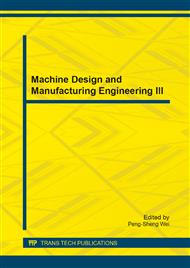p.542
p.547
p.551
p.556
p.561
p.565
p.569
p.573
p.577
Valveless Pump in Closed Loop Tube System
Abstract:
This research work aims to identify the characteristic of flow in valveless impedance pump which uses acoustic impedance mismatch to drive flow. The experimental setup mainly focuses on the elastic section connected between two ends of rigid tube. Fluid flow rate resulting from the pumping mechanism were measured at different supply voltage. Meanwhile, the volume flow rate (ml / min) in the elastic tube section were also determined based upon different pinch location and width using water as a working fluid. In order to achieve these parameters quantification, the experimental test rig was designed and the set of equipments were successfully assembled. Then, the measured parameters resulting from the experiment of the impedance pump are presented in significant findings of four curves plots. It is found that the maximum flow rate occurred at voltage setting equal to 4 V. Significantly, results obtained could beneficial future design as a mimics model for novel Ventricular Assist Device use in cardiac patient as well as further explanation about the factor that influence the characteristic of valveless impedance pump.
Info:
Periodical:
Pages:
561-564
Citation:
Online since:
July 2014
Authors:
Keywords:
Price:
Сopyright:
© 2014 Trans Tech Publications Ltd. All Rights Reserved
Share:
Citation:


